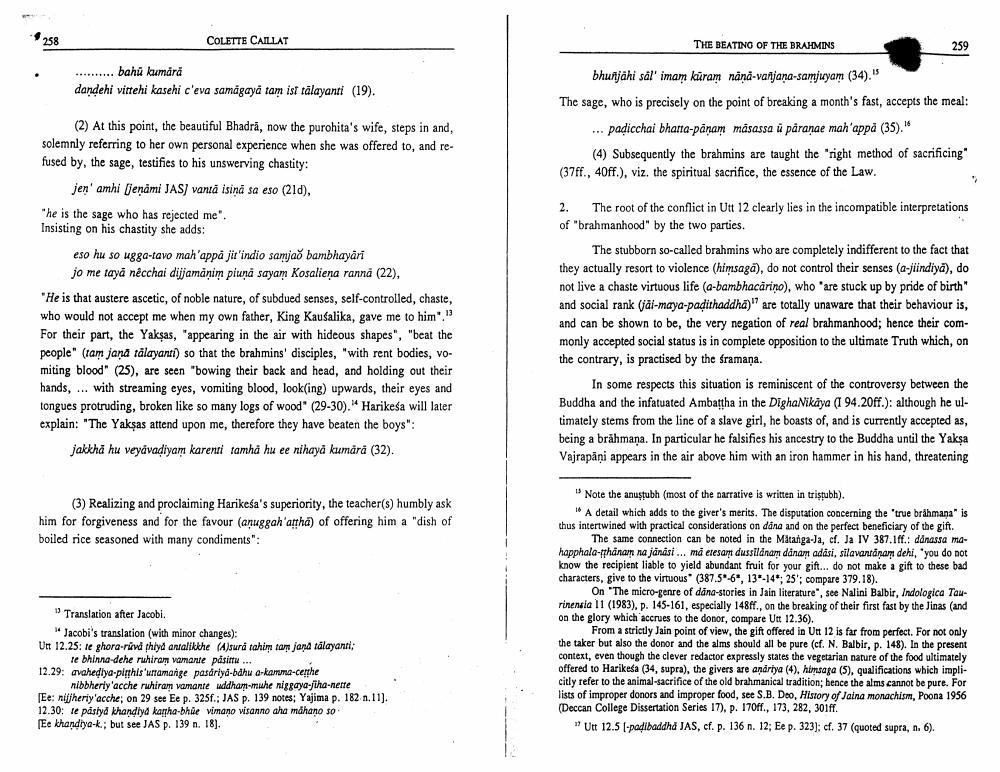________________
288
COLETTE CAILLAT
THE BEATING OF THE BRAHMINS
259
.......... bahü kumara dandehi viftehi kasehi c'eva samägaya tam ist tälayanti (19).
bhunjahi sál' imam kuram nână-vanjana-samjuyam (34)." The sage, who is precisely on the point of breaking a month's fast, accepts the meal:
... padicchai bhatta-pānam mäsassa ú påranae mah'appå (35)."
(4) Subsequently the brahmins are taught the "right method of sacrificing (37ff., 40ff.), viz. the spiritual sacrifice, the essence of the Law.
(2) At this point, the beautiful Bhadră, now the purohita's wife, steps in and, solemnly referring to her own personal experience when she was offered to, and refused by, the sage, testifies to his unswerving chastity:
jen' amhi (jenami JAS) vanta isina sa eso (21d), "he is the sage who has rejected me". Insisting on his chastity she adds:
eso hu so ug ga tavo mah'appå jit'indio samjað bambhayari
jo me tayā nêcchai diijamānim piună sayam Kosaliena ranna (22), "He is that austere ascetic, of noble nature, of subdued senses, self-controlled, chaste, who would not accept me when my own father, King Kausalika, gave me to him." For their part, the Yakşas, "appearing in the air with hideous shapes", "beat the people" (tam jana ralayanti) so that the brahmins' disciples, "with rent bodies, vomiting blood" (25), are seen "bowing their back and head, and holding out their hands, ... with streaming eyes, vomiting blood, look(ing) upwards, their eyes and tongues protruding, broken like so many logs of wood" (29-30). Harikesa will later explain: "The Yakşas attend upon me, therefore they have beaten the boys":
jakkha hu veyavadiyam karenri tamhå hu ee nihaya kumará (32).
2. The root of the conflict in Utt 12 clearly lies in the incompatible interpretations of "brahmanhood" by the two parties.
The stubborn so-called brahmins who are completely indifferent to the fact that they actually resort to violence (himsaga), do not control their senses (a-jiindiya), do not live a chaste virtuous life (a-bambhacarino), who are stuck up by pride of birth and social rank (jai-maya-padithaddha)" are totally unaware that their behaviour is, and can be shown to be, the very negation of real brahmanhood; hence their commonly accepted social status is in complete opposition to the ultimate Truth which, on the contrary, is practised by the framana.
In some respects this situation is reminiscent of the controversy between the Buddha and the infatuated Ambattha in the Digha Nikaya ( 94.20ff.): although he ultimately stems from the line of a slave girl, he boasts of, and is currently accepted as, being a brāhmaṇa. In particular he falsifies his ancestry to the Buddha until the Yakşa Vajrapāņi appears in the air above him with an iron hammer in his hand, threatening
(3) Realizing and proclaiming Harikeśa's superiority, the teacher(s) humbly ask him for forgiveness and for the favour (anuggah'artha) of offering him a "dish of boiled rice seasoned with many condiments":
Translation after Jacobi.
Jacobi's translation (with minor changes): Un 12.25: Te ghora-rüd thiyd antalikithe Asurà tahim sarjan tálayanti,
re bhinna dehe ruhiram amante posit... 12.29: avahedlya-pighis'utamange pasdrlyd-bdhu e-kamma-cephe
nibbherly'acche ruhiram amante ddham-mahe niggaya-jihanette Ee: nijjheriy'acche, on 29 see Ee p. 325f.: JAS p. 139 notes: Yajima p. 182 n. 11). 12.30: Te pastyd khandlyd kaha-bhúe vimano visanno aha mdhano so (Ee khandrya-k; but see JAS p. 139 n. 18).
"Note the anustubh (most of the narrative is written in trisfubh).
A detail which adds to the giver's merits. The disputation concerning the true brahmanais thus intertwined with practical considerations on dana and on the perfect beneficiary of the gift.
The same connection can be noted in the Matanga-Ja, cf. Ja IV 387.1ff.: dánassa mahapphala-thinam na jandsl... md elesamt dussilánam danam adasi, silavandnam dehi, 'you do not know the recipient liable to yield abundant fruit for your gift... do not make a gift to these bad characters, give to the virtuous (387.5"-6", 13-14, 25': compare 379.18).
On 'The micro-genre of dana-stories in Jain literature", see Nalini Balbir, Indologica Taurinensia ll (1983), p. 145-161, especially 1487., on the breaking of their first fast by the Jinas (and on the glory which accrues to the donor, compare Ust 12.36).
From a strictly Jain point of view, the gift offered in Uit 12 is far from perfect. For not only the taker but also the donor and the alms should all be pure (cf. N. Balbir, p. 148). In the present context, even though the clever redactor expressly states the vegetarian nature of the food ultimately offered to Harikasa (34, supra), the givers are andrtya (4). hintaa (5). qualifications which implicitly refer to the animal-sacrifice of the old brahmanical tradition; hence the alms cannot be pure. For lists of improper donors and improper food, see S.B. Deo, History of Jaina monachism, Poona 1956 (Deccan College Dissertation Series 17). p. 170ff., 173, 282, 301ff.
Urt 12.5 I-padibaddhd JAS, cf. p. 136 n. 12; Ee p. 323): cf. 37 (quoted supra, n. 6).




